| |
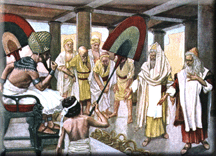
Aharon the Priest—
Part II
Copyright © August 2024
by Moshe Aharon (Morris) Shak
Introduction
Is Aharon's (Aaron's) life outlined in detail in a short section in the Bible where the term Aharon is found at an overwhelming frequency? In Aharon the Priest—Part I, I outlined the first half of my findings in response to that question. This article presents the second half of my findings on the life of Aharon as outlined in the codes.
The Priestly Blessing by Aharon and His Sons the Priests
In Leviticus 1:1-13, the subject is the function of the priestly duties of Aharon the priest and his sons the priests. It is the first time that their duties are outlined, but not the only time. Below is another portion in the Torah where their duties are outlined:
And the LORD spoke unto Moses, saying: Speak unto Aaron and unto his sons, saying: On this wise ye shall bless the children of Israel; ye shall say unto them: The LORD make His face to shine upon thee, and be gracious unto thee; The LORD lift up His countenance upon thee, and give thee peace. —Numbers 6:22-26 (emphasis mine)
In synagogues, these verses are recited daily, and in many synagogues, the priests (cohanim) take an active role by reciting them up to once a week. On a daily basis, there are other quotations from the Bible that are recited from the prayer books:
The LORD will give strength unto His people; the LORD will bless his people with peace. —Psalms 29:11 (emphasis mine)
The Torah is a tree of life, and all its path are peace. — Proverbs 3:17-18 (paraphrase mine)
Raban Gamliel says: "The world exists/based on three things: the law; and on the truth and on peace." (As) It is written in Zechariah 8:15. "Truth and justice and a peaceful verdict you shall judge in your gates." —Mishna Perkie Avot verse 18 (emphasis mine).
Here is the Hebrew for these verses.

From the above, it is clear that it is through Hashem's blessing that there will be peace, and it was given by Hashem, to give to Moses, to pass on to Aharon and his sons. Therefore, it is remarkable to find in a 465-letter matrix that outlines the duties of Aharon and his sons, the following code:

And who is asking for peace for the nation? As we are told by our sages and as the codes indicate below, it is told by the man who claims:

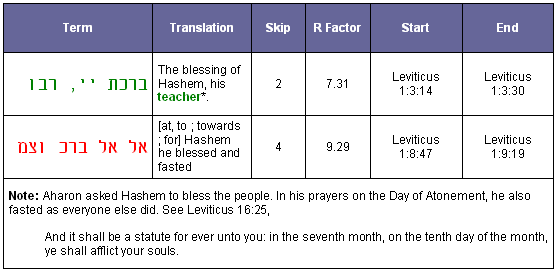
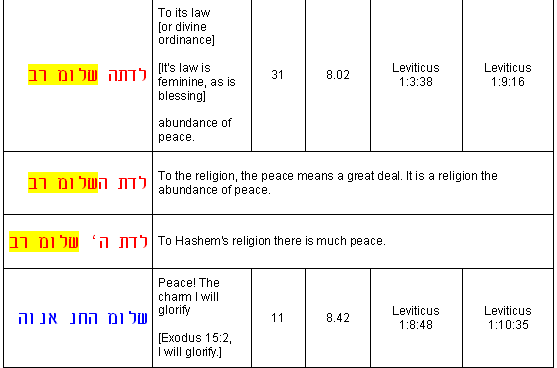
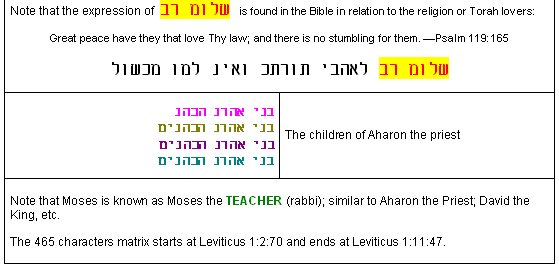
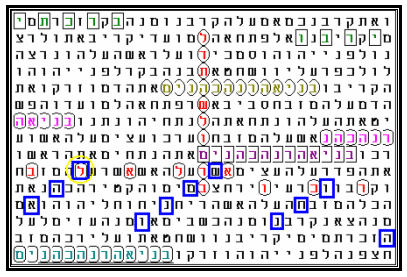
It must be seen above, that had the term  — the children of Aharon the priest, been extended by two letters, and then the fascinating full-length term and the term peace would not exist. Furthermore, the divine ordinance of much peace, twice shares a letter with the term priests in the children of Aharon the priests and the term: — the children of Aharon the priest, been extended by two letters, and then the fascinating full-length term and the term peace would not exist. Furthermore, the divine ordinance of much peace, twice shares a letter with the term priests in the children of Aharon the priests and the term:  — the children of Aharon the priest appears at the middle of the main term of peace. — the children of Aharon the priest appears at the middle of the main term of peace.
The top line in the matrix has in green on the right, the term  — my blessing, and the bottom line on the right has the term: — my blessing, and the bottom line on the right has the term:  — the children of Aharon the priests. — the children of Aharon the priests.
It is a very fitting message:
My blessing—children of Aharon the priests.
Hashem's blessing has been now recited for generations by the priests, who are the descendants of Aharon.
It is interesting that Aharon the Priest who is best known as a person who loves peace and pursues peace is given the religious duty to bless his beloved Jews with abundance of peace. Blessing the Jews with peace was a regular duty of Aharon, and his sons and all their offspring to this day.
The Pleasant One, Who Loves Every Jew and Finds Harmony Beautiful
I have always claimed that the main reason for the Bible codes is not for use as a fortunetelling tool, but rather to glorify Hashem. They show in amazing ways that His teachings in the Torah and in the oral law are also concealed in many ways where the Bible codes are just one of the many tools. The oral law in Judaism is expounding on the Torah that we believe was passed from Moses to Joshua, to the elders, prophets, etc. In the book of Perkie Avot, we find some of these teachings that were committed to writing many centuries ago. To understand the splendor in the hidden Bible codes in the first 13 verses of the Book of Leviticus, one must first understand what has been written about Aharon the priest a long time ago. I believe that the reason for such a concentration of Aharon terms in those 13 verses is because they contain such pertinent information about his life achievements, dedication, and love for his fellow Jews. Those Aharon terms were designed to draw attention to the hidden messages in this area.
If you look in the Internet for  , you will find many articles on the subject such as Illuminating the Dark Tunnel by Rabbi Dr. Aaron Adler. , you will find many articles on the subject such as Illuminating the Dark Tunnel by Rabbi Dr. Aaron Adler.
Aharon was best known for his love for all the people seeking at every juncture to promote peace and tranquility. Hillel the Elder, in Pirkei Avot 1:12 taught:

Hillel would say: Be of the disciples of Aharon—a lover of peace, a pursuer of peace, one who loves the creatures and draws them close to Torah.
That Aharon was so loved, adored, and admired by the entire nation is evident by the fact that absolutely everyone mourned his death.

In contradistinction, we find that at the passing of Moses, the Torah (Deuteronomy 34:8) speaks of

Conspicuously absent in this verse is the word   (all of Israel). Rashi there points out it was Aharon's character and personality that drew him so much closer to the nation as opposed to Moses' relationship with the people. (all of Israel). Rashi there points out it was Aharon's character and personality that drew him so much closer to the nation as opposed to Moses' relationship with the people.
Hillel the Elder's quotation is so well imprinted on any student that learned Torah, that the first thing that I looked for in the codes was the term     , or loves. The term that I found baffled me. There was a nun after the term love spelling , or loves. The term that I found baffled me. There was a nun after the term love spelling  . In checking out the appearances of such a love term, I found many references such as the one below spelling out an abundance of love to the creatures. The next challenge I faced was to explain the second term that followed love. It spells . In checking out the appearances of such a love term, I found many references such as the one below spelling out an abundance of love to the creatures. The next challenge I faced was to explain the second term that followed love. It spells     , which has a definite meaning in Hebrew—meaning paid. I still did not know at the time what Aharon was paid. The codes spell it out clearly, but let's first look closer at the term. It struck me how much this term looks like shalom, where all we have to do is switch the lamed with the vav. , which has a definite meaning in Hebrew—meaning paid. I still did not know at the time what Aharon was paid. The codes spell it out clearly, but let's first look closer at the term. It struck me how much this term looks like shalom, where all we have to do is switch the lamed with the vav.
You will not find the above term in the dictionary, but it is on the Internet, because I've used it and heard it used numerous times. First of all, in Hebrew, one does not say shalom but shulem. All European Jews are familiar with the term. However, as I was a child in Israel, I know that all Israeli children know it as well. Perhaps one reason is that term is so very well suited here is because small children often have fights and then they make up. This process may repeat several times. There is one word to describe in Hebrew the state of being mad and not talking to one another. We are brogrz (we are in anger). To nullify the situation we make sholem. Aharon, with his infinite love, treated the children of Israel like his own children in the sense of making sholem between husband and wife, father and son, brother and sister, or friends. Just as adults resolve negative situations among children, so did Aharon among adults. The main term below spells out:
To the one who loves them, harmony/peace is beautiful.
The next main term asks the people to allow him (to make peace), or to give him (honor).
Give to the pleasant Aharon
Note:
- Both vertical, long terms would be nullified, if the term children of Aharon the priest were to become: children of Aharon the priests.
- Both vertical long terms, share a nun with a corresponding term of the children of Aharon the priests.
- There is a connection between the lover of peace and the name Aharon in the two parallel vertical terms. Besides being parallel and close by, and sharing the letters nun, they both use the term pleasant/beautiful.
From Yshilo, we find the following:

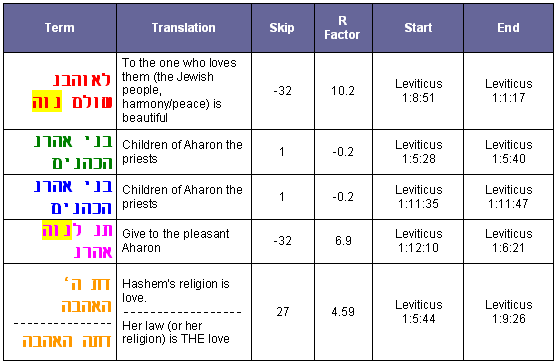

In the matrix below on the right, a couple of terms are added. The green term spells out  or it reads: the present of Amram. Note that Amram was the father of the three most famous characters in the Exodus story: Miriam, the prophetess, who is credited with the famous water well; Moses, the deliverer, who is credited with the manna; and Aharon, the priest, who is credited with the clouds of glory. Aharon was the most beloved gift to the Jews as was outlined above by Hillel the Elder. The term Aharon appears also at the skip of -64 in parallel to the other two main terms to add emphasis that we are speaking about Aharon. Finally, the term the children of Aharon the priest is outlined in yellow for yet another emphasis on Aharon AND to show that had there been any more letters after that term to make it cohanim instead of cohen the two main terms would not exist. or it reads: the present of Amram. Note that Amram was the father of the three most famous characters in the Exodus story: Miriam, the prophetess, who is credited with the famous water well; Moses, the deliverer, who is credited with the manna; and Aharon, the priest, who is credited with the clouds of glory. Aharon was the most beloved gift to the Jews as was outlined above by Hillel the Elder. The term Aharon appears also at the skip of -64 in parallel to the other two main terms to add emphasis that we are speaking about Aharon. Finally, the term the children of Aharon the priest is outlined in yellow for yet another emphasis on Aharon AND to show that had there been any more letters after that term to make it cohanim instead of cohen the two main terms would not exist.
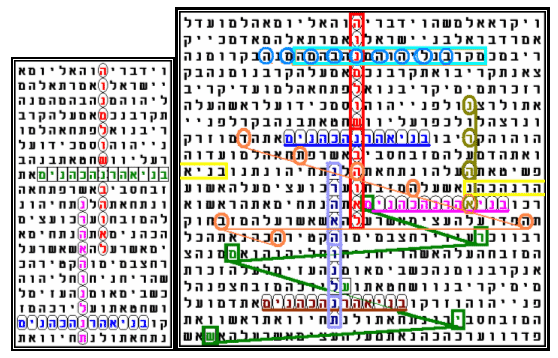
At this point, we are ready to appreciate one of the several ways that Aharon was paid. As Hillel the Elder teaches us that Aharon brought the children of Israel peace and closer to the Torah, the red term has the term of peace and the orange term tells us that he brought them closer to the Torah. It specifies that he got them closer to Hashem. That is the same as closer to his Torah, because to love Hashem you must know how. The Torah teaches that.
Hashem in the Scriptures tells us about a "new heart" (see Ezekiel 18:31 for one of many examples of a new heart). The top blue circled term is outlining that Aharon built them a new heart (to love Hashem). He shocked them with his ways of love. His loving heart worked on their heart. They loved Aharon also with all their heart, as is told in the Bible when the story of his passing unfolds.
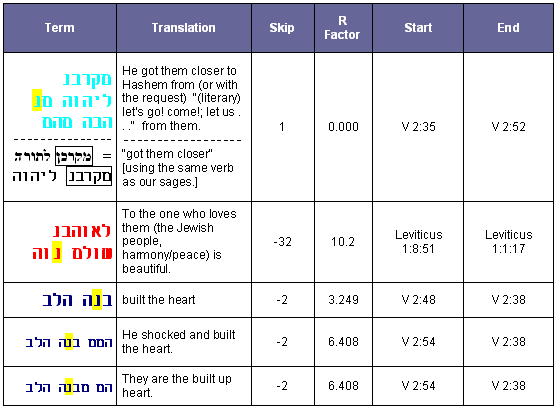
Love
In the sections above, the two peace and love terms below were introduced. Note, however, the parallel in the structure of the message about the religion:
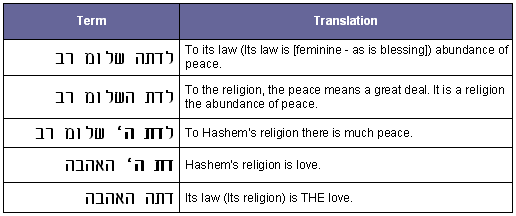
It must be appreciated that love and peace are two major pillars of the Jewish religion and that Aharon and his children play a major role in the concept. The role of peace was already discussed above. Love is another key factor:
- The famous Rabi Akiva was asked to teach the Torah in a "few minutes." The reply was LOVE your friend as you love yourself—the rest of the Torah expounds on the principle. See note 1 below.
- A Jew is to declare his faith in Hashem twice a day with LOVE.
- The second sentence in the declaration from Deuteronomy 6:5 states: And thou shalt LOVE the LORD thy God with all thy heart, and with all thy soul, and with all thy might.
- Aharon and his sons the priests were commanded by Hashem to bless the nation with LOVE for Hashem to bestow good fortune and PEACE (i.e., the blessing recited in synagogue by the priests):

Notes
- Leviticus 19:18: Thou shalt not take vengeance, nor bear any grudge against the children of thy people, but thou shalt love thy neighbour as thyself: I am the LORD.
- If we all loved one another, there would not be war in this world. There would be PEACE.
Depart from evil, and do good; seek peace, and pursue it.
—Psalms 34:15 (emphasis mine)
Aharon's actions were the inspiration for the verse above. On numerous occasions, the Bible states obligations starting with the word ki — when or if. Those are obligations that will not come across the path of any given person necessarily. To seek peace AND pursue it if it is not at hand, is an obligation of all human beings. Aharon is a role model for that obligation.
It was all due to Aharon's great love for his fellow men, his great desire for peace among them, and his ways of achieving this goal and drawing them closer to Hashem that his name and his offspring are associated with loving their fellow men and blessing them with peace.
Gold
Gold played a major role in the life of Aharon. It was both for the good and for the bad. In Exodus 28, the text outlines the special garments, decorations and special clothing that Aharon was to use. He had to be distinguished and full of splendor. The term  — With a sign of Gold he was adorned is remarkable. — With a sign of Gold he was adorned is remarkable.
Aharon also stumbled when with good intentions he produced the golden (young, male) bull —
 . From the gold that Aharon collected and melted down (crumbled?) a huge issue was produced (a mountain). Aharon wanted to give Moses a chance to return from the mountain (Sinai), and thought that the people would refuse to part with their gold. They did not hesitate to give their gold. However, the gold played a role to crumble the principles that were given on THE Mountain (Sinai) and produced an image, and "created" a new "G-d." . From the gold that Aharon collected and melted down (crumbled?) a huge issue was produced (a mountain). Aharon wanted to give Moses a chance to return from the mountain (Sinai), and thought that the people would refuse to part with their gold. They did not hesitate to give their gold. However, the gold played a role to crumble the principles that were given on THE Mountain (Sinai) and produced an image, and "created" a new "G-d."
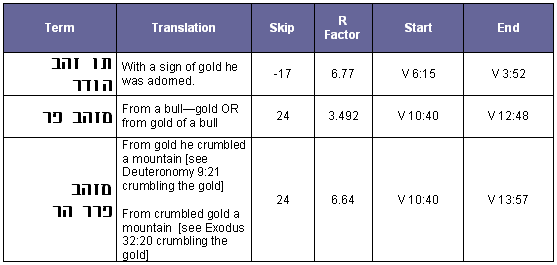
Note the true meaning of two terms that run within one another at the skip of 24:
 — From the gold of an ox, gold he crumbled — From the gold of an ox, gold he crumbled
In the Bible, the term golden calf or egel refers to the male gender of a young bull. However, as it is illustrated in The Humility / Modesty / Meekness section towards the end of this article, the letter gimel, which is used to spell egel, is not present in the matrix. Note that the gimels are red squares at the top and bottom of the matrix, while the first 17 verses of Leviticus are outlined in a red border (see the matrix in the section titled The Altar towards the end of this article).
The 10 Commandments Tablets
Note that the term tablets is spelled in several ways in the Torah, just as the term generation or dorot is spelled in several ways. In the first appearances in Exodus, the term tablets does not have any vavs. In Deuteronomy, it appears with a vav as shown below. The first term below in chronological sequence describes that the tablets were for the people. The second term describes the terrifying experience for Hashem's creation when the tablets were being smashed, and the terrifying experience the dust from the tablets had on the people who were forced to drink them. Aharon is a major player in the creation of the golden image, the terrifying effects of breaking up the tablets and the punishments that followed.
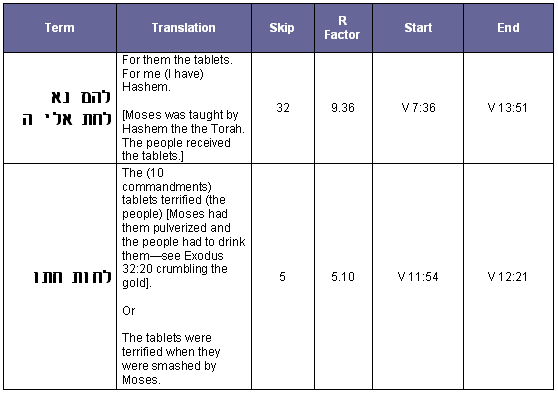
Mountain Hor (the burial site for Aharon)
Alas, Aharon was not allowed to enter the Promised Land and passed away before the children of Israel entered. Alas, he was buried in a cave on Mountain Hor. We are told that the mountain was indeed a mountain upon a mountain. If one looks at the Hebrew writing of HoHar, one can see that the spelling hints of two mountains:      . Note that Hor may be spelled with or without the letter vav. We are also told that once Moses left Aharon in the cave, the cave disappeared and no one knows the exact location of the cave or the mountain. . Note that Hor may be spelled with or without the letter vav. We are also told that once Moses left Aharon in the cave, the cave disappeared and no one knows the exact location of the cave or the mountain.
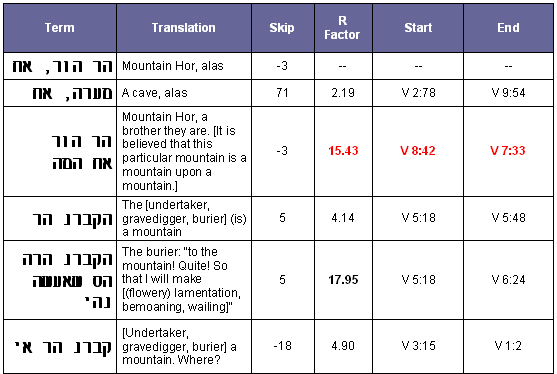

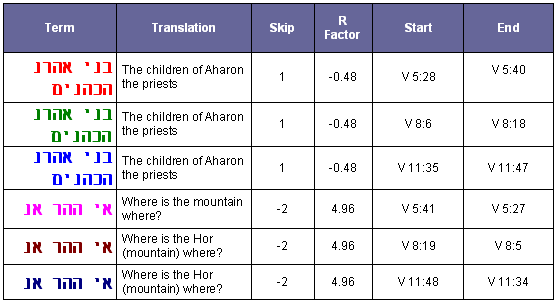
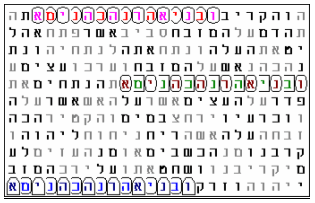
Crying
We know that Aharon was THE priest and that he loved and pursued peace, and drew the Jews to the Torah. The Torah also tells us about the personal tragedy that Aharon suffered on the day that he was appointed to become the priest. The story of Aharon losing his two sons is complex, but commentaries discuss the merit and lack of merit of the sons, the functions of the two types of fires, and the two types of sacrifices associated with the incident. Hashem commanded a specific fire to be used for ceremonial purposes, but the sons, Nadav and Avihu, used a strange fire. They used a "bad" fire as opposed to the "good" fire as commanded. And then, a fire was produced by Hashem to consume them. They needed the fire to offer incense to Hashem, but commentators also point out their great love of Hashem, as misguided as they may have been, they sacrificed their lives.
If we look at the term: A sea of fire—it is bad for the fire. Fire is bad for them they sacrificed, offered a sacrifice, we can see the double fire, and the double sacrifice. As we can see in the table below, the above term coincides with the term: Let's have a great deal of crying. A father just lost two of his sons. The term To this much crying there is an incident as shown below, may refer to the same incident. However, there was another incident related to Aharon and death. The incident was Aharon passing with everyone crying for him. The Torah emphasizes that ALL cried for him for 30 days. The Torah puts more emphasis on crying for Aharon, than for Moses. As our sages explain, it is possible that as the first two terms in the table below indicate that Moses was a judge (that is until Jethro came to visit him, Moses judged the people all day) and was known at least on one occasion to be angry when he struck the rock to obtain water. Aharon, on the other hand, did not judge the people. He taught them to love one another, and they loved him and mourned deeply when they lost him. The first two terms in the table below support our sages' writings about the reasons for the crying over Aharon more than Moses. The loser in a court case typically feels that the judge did not impart perfect justice. One way or another, the final two terms below emphasis that The nation wept: "Hashem, Hashem" and And woe, Hashem wept.
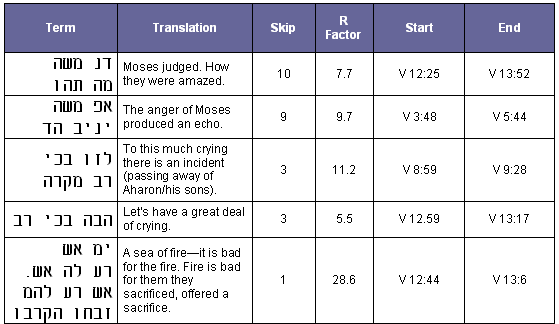
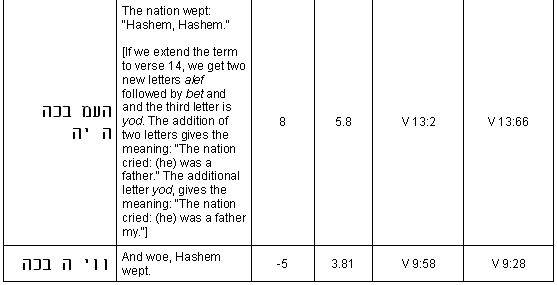

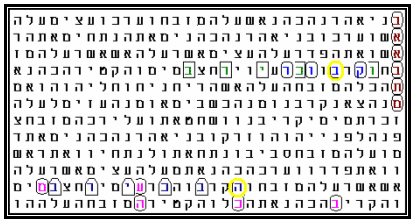

If we concentrate only on one small area in the matrix that has 8 rows, is 23 columns wide and contains a total of 184 characters below we get a concise story:

The matrix starts at Leviticus 1:5:46 and ends at Leviticus 1:10:26.
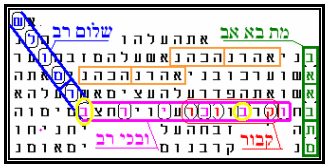
[Shak received some assistance from Professor Eliyahu Rips with the matrix above.] Note that Shalom Rav, and Bechi Rav share the same letter bet. Both terms end with the word Rav, that means both "much" and "rabbi." "Much crying" can also be read as "crying for a rabbi." "Much peace" can be a farewell statement to the dead, and it can be also be read as the term President Clinton used to address the deceased Prime Minister Itzchak Rabin: "Shalom Chaver" — "Goodbye Friend." In our case, we can also see the term stating: "Goodbye Rabbi." Although Moses was THE rabbi for all generations, Aharon did fulfill the functions of a rabbi. This is a very compact matrix with interconnected terms sharing letters, terms within terms, and almost touching terms, with multiple correct interpretations.
Forgiveness
The golden covering of the ark was called the Kaporet. Two images of angels facing one another were on the Kaporet as shown in the picture below. It was made of gold just as the golden calf was made of gold, and was made to provide forgiveness for the golden calf. From Exodus 25:17-22, we understand that from the Kaporet area—the Holy of Holies, Hashem was to communicate with the High Priest. In Judaism, the term  or forgiveness of sins is used extensively for all offenders in general, and on the Day of Atonement in particular. It was Aharon's duty as the High Priest to ask Hashem to forgive all. or forgiveness of sins is used extensively for all offenders in general, and on the Day of Atonement in particular. It was Aharon's duty as the High Priest to ask Hashem to forgive all.
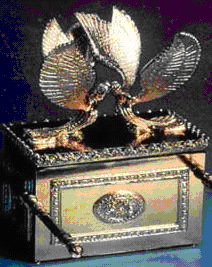
The term below may mean two things:
- Aharon is asking Hashem from the Kaporet area for forgiveness, or
- Hashem is telling Aharon to ask for forgiveness from the Kaporet area.
Aharon's offspring, who became the High Priests, would in the future continue in the tradition.
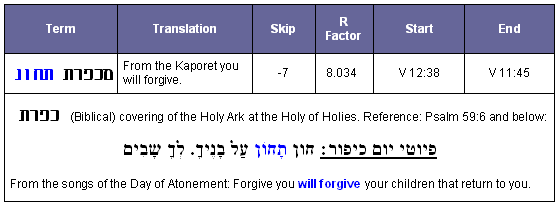
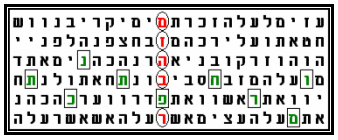
The green term  intertwines and shares a letter with the term intertwines and shares a letter with the term  . The above is a play on the theme stated above: It was made of gold just as the golden calf was made of gold, and was to provide forgiveness for the golden calf. . The above is a play on the theme stated above: It was made of gold just as the golden calf was made of gold, and was to provide forgiveness for the golden calf.
The Clouds of Glory
Based on Talmudic literature containing legends based on Biblical verses and a collection of Jewish laws with homiletic interpretations, we are taught that the clouds of glory that protected and led the children of Israel for 40 years were there in the merit of Aharon the priest. (See reference in Hebrew at Da'at.co.il.) Upon the death of Aharon, the children of Israel who did not have the clouds of glory to protect them were attacked by the Canaanites and lost:
And when all the congregation saw that Aaron was dead, they wept for Aaron thirty days, even all the house of Israel. [End of chapter 20] And the Canaanite, the king of Arad, who dwelt in the South, heard tell that Israel came by the way of Atharim; and he fought against Israel, and took some of them captive. —Numbers 20:29–21:1
In the table below, there are two long terms at very high R Values. The second term is shown in four variations. However, the incredible story below is:
I will sanctify the cloud, Let there be happiness! They (the children of Israel)
camped within My clouds, ate, drank, and were able to follow by (my leading) cloud.
(Upon Aharon's death) they cried on the loss of My clouds.
The codes appear to be the voice of Hashem, but it could also be taken as spoken by Aharon. The clouds protected them from the sun and all their enemies (men and wildlife) and the cloud led them across the desert for 40 years.
There is much more depth to the codes than a simple message. The codes actually confirm that when Aharon passed away, the cloud(s) FINISHED its/their function.
First Clue
Let's have a quick look at a code to be introduced in the next section:
 — He died on the first of Av. — He died on the first of Av.
Skip = -32; R Factor = 2.63; Start = Leviticus 1:10:4; End = 1:7:6
If we look at the same sequence of letters from left to right we get:
 — On the first of Av it finished. — On the first of Av it finished.
Skip = 32; R Factor = 2.63; Start = Leviticus 1:7:6; End = 1:10:4
The code is telling us that something ceased to exist on the same date as the date of Aharon passing. To confirm the intent of this code, we have another code:
Second Clue
 — I shall sanctify a cloud. — I shall sanctify a cloud.
Skip = 54; R Factor = 3.80; Start = Leviticus 1:2:12; End = 1:7:6
Note that now we have two codes in a row: The first starting in verse 2 beginning with I will sanctify a cloud. At the same exact spot and at Leviticus 1:7:6, the first term ends and the second term starts: On the first of Av it is finished. The second term ends in verse 10.

See the term  in the matrix below, connected to in the matrix below, connected to  . .
Third Clue
The above is a very clear indication on its own merit that the date of Aharon passing is the date the cloud ceased to exist. But there is another indication in the codes. Within the term: On the first of Av it finished, there is another code: They followed on my cloud (or waited for my cloud).
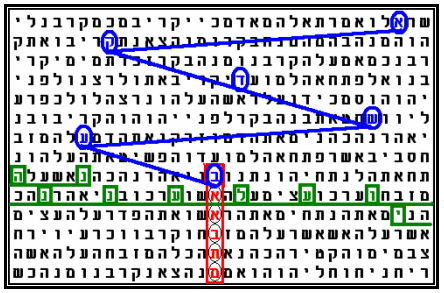
The two codes intertwine showing that they work together to give the message that the following of the cloud stopped on the date that Aharon passed away.
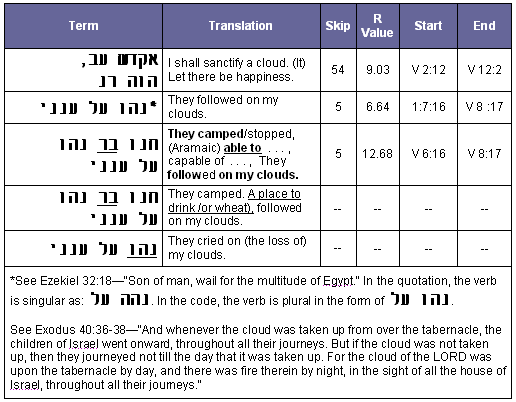
The First of Av, the Date of Aharon Passing
The Bible tells us about Aharon's passing as follows:
And Aaron the priest went up into mount Hor at the commandment of the LORD, and died there, in the fortieth year after the children of Israel were come out of the land of Egypt, in the fifth month, on the first day of the month. —Numbers 33:38 (emphasis mine)
Incredibly, the codes specify not only the specific date of Aharon's death, but also precede it by specifying that he died on the exact date. There are two codes saying:
On the first of the month of Av, woe!
Oh, oh, from something golden.
(He) died on the first of Av.
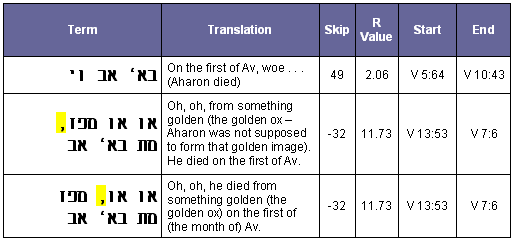
Note that after the creation of the golden image, Hashem was going to destroy Aharon.
Moreover the LORD was very angry with Aaron to have destroyed him; and I prayed for Aaron also the same time. —Deuteronomy 9:20
The Altar
The term the altar is mentioned several times in the surface text of the first 13 verses of Leviticus. It can be found only one more time at any other skip. A mini-matrix formed by this term is shown below. However, first let it be understood that the altar was designed to be used only by Aharon and/or his children. The term in blue below intersects exactly at the mid-point with an identical altar term. It also shares two different letters with two identical terms specifying the children of Aharon [the priest]. The word priest is shown in the top term, but not in the bottom term. Basically, the children of Aharon were the chosen ones to use the altar. But why do they need the altar? The altar is the vehicle to bring the sacrifice or in Hebrew korban from the root karev—to draw the transgressor closer to Hashem. It is the function of the children of Aharon to facilitate the granting of forgiveness to the transgressor. The term in red is the missing link in the story of the children of Aharon and the altar.

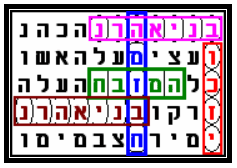
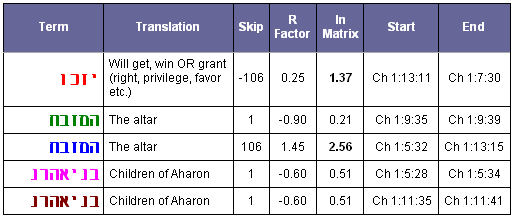
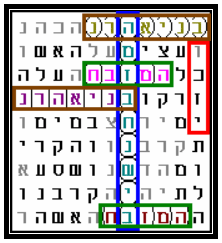
If we extend the term the altar as shown above, we get the promise that our sages have taught us for generations: The sacrifices on the altar will return and the priests will perform it. The message says: the altar we shall bring back. The larger matrix below shows repeated terms such as the children of Aharon the priests, and the terms the altar. It also indicates the first 13 verses in Leviticus within the red border.
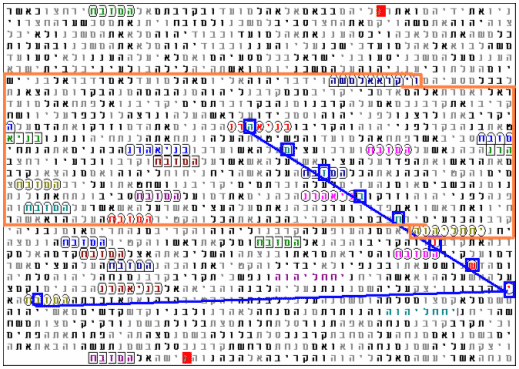
The Humility / Modesty / Meekness
In the Torah, Moses is described as the most humble (   ) man on earth. ) man on earth.
Now the man Moses was very meek, above all the men that were upon the face of the earth. —Numbers 12:3
A man who is    — humble exhibits — humble exhibits     — humility. — humility.
Aharon, who was a lover and pursuer of peace, is also described as a humble and modest person. It was not below his dignity to actively encourage others to make peace, as opposed to wait for others to come to him in his office of the high priest.
Modesty was always in them.
 — Always modesty / humility — Always modesty / humility
 — In them He made modesty / humility — In them He made modesty / humility
Indeed, Aharon implored for humility among those who quarreled and tried to sweetly talk to them and soften their hearts.
 — Only [humility, modesty] — Only [humility, modesty]
He implored (flowery) to implore, to beg; (Talmudic) to sweeten, to soften. And their humility echoed.
 — And the modesty / humility an echo — And the modesty / humility an echo
Where did they get this trait? We have been taught over the centuries that Amram, the father of Moses, Aharon and Miriam, was the leader of his generation, and all the people looked up to him. It must have been this great father's gift to his sons.
 — The gift of Amram — The gift of Amram
The table below is the summary of the story above. The them in the Bible code probably refers both to Moses and Aharon, as well as the children of Aharon. The children of Aharon, are still descendents of Amram. Note in the main term that he made them modest may refer to Amram or Hashem. The term the gift of Amram shares the ayin (see the yellow highlight). Also, the term the modesty made an echo, shares a heh: (heh in blue highlight), (i.e., there is an interconnection in the terms and in the ideas).
There is, however, another curious factor. The opposite of modesty     , is pride/egotism , is pride/egotism     . It is impossible to find this term "pride" in the 13 verses where Aharon, and his children, are so very prominent. The gimel—the first letter in "pride" does not appear there or in many verses before and after that section. Wherever Aharon is found so prominently, pride cannot be initiated to any degree. No matter how large the skip, the gimel is simply not there. I have been taught that the cohanim were commanded not to allow pride to overtake them, and serve as a model to the transgressors that came to them to atone for their sins. The cohanim had a great model to follow—a man who always was modest and humble: Aharon the priest—their forefather. . It is impossible to find this term "pride" in the 13 verses where Aharon, and his children, are so very prominent. The gimel—the first letter in "pride" does not appear there or in many verses before and after that section. Wherever Aharon is found so prominently, pride cannot be initiated to any degree. No matter how large the skip, the gimel is simply not there. I have been taught that the cohanim were commanded not to allow pride to overtake them, and serve as a model to the transgressors that came to them to atone for their sins. The cohanim had a great model to follow—a man who always was modest and humble: Aharon the priest—their forefather.
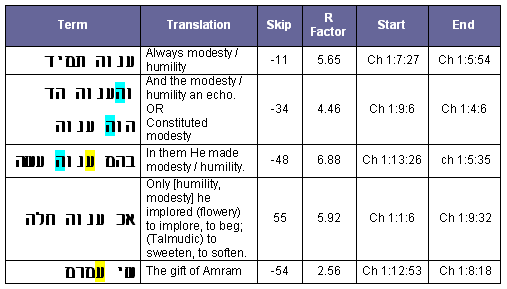
He (Aharon the Priest) Held a Senior Position as a Priest from a True Religion


Moses' Mouth
The only time that the Torah uses the term to thee a mouth (   ) is in Exodus 4:16, "And he shall be thy spokesman unto the people; and it shall come to pass, that he shall be to thee a mouth, and thou shalt be to him in God's stead." (emphasis mine) The same mouth term is found in the subject matrix, and it intersects at three places with another long term. Both terms combine to form the same message quoted above. When Moses went to Pharaoh angrily to demand "Let my people go!" it was Aharon that was Moses' mouth. Indeed, Aharon produced what can be described as "echoing Moses words." Indeed, Aharon had a double echo. First, Moses "echoed" Hashem's message, then Aharon "echoed" that echo. ) is in Exodus 4:16, "And he shall be thy spokesman unto the people; and it shall come to pass, that he shall be to thee a mouth, and thou shalt be to him in God's stead." (emphasis mine) The same mouth term is found in the subject matrix, and it intersects at three places with another long term. Both terms combine to form the same message quoted above. When Moses went to Pharaoh angrily to demand "Let my people go!" it was Aharon that was Moses' mouth. Indeed, Aharon produced what can be described as "echoing Moses words." Indeed, Aharon had a double echo. First, Moses "echoed" Hashem's message, then Aharon "echoed" that echo.


Conclusion
The codes are in excellent Hebrew and combine key words per code to describe flawlessly Aharon's life. The exhaustive research and demonstration of the large number of Aharon terms in such a short span of letters is divine, but it will never satisfy the skeptic. In the eyes of the skeptic, it is an anomaly no matter what the odds are against finding such a phenomenon. However, what if in the same span of letters there are numerous other ELSs defining Aharon in terms recorded in the Bible and Jewish tradition for many generations? Better yet, can one create today with the aid of computers such a complex set of coded messages on any topic? Can someone then interweave that portion of the Bible with other portions of the Bible that are also independently coded with other messages?
Knowledge is power, and while our knowledge and power is nil in comparison to the divine, we are lucky to get a glimpse at His road map called the Torah—a living tree. May we all receive the blessing given by Hashem, written by Moses and delivered by Aharon and his children the priests.
[All Scripture quoted is from CodeFinder: Millennium Edition.
Moshe Shak bases his matrices on strict rules as outlined in his book Bible Codes Breakthrough. He only uses statistically significant terms, and many other strict rules to minimize the chance of presenting bogus "codes." Contact Moshe at moshe@mshak.ca.]
Moshe Aharon Shak is a frequent contributor to BCD. If you are interested in reading more articles by Shak, be sure to visit the Directory of Moshe Aharon Shak's Articles for links to his other articles posted on BCD's site.
|
Enjoy finding your own Bible codes.
Bible code search software is available in our online store.
Subscribe Free! Sign Up Today!
Become a member of the non-profit Isaac Newton Bible Code Research Society.
Not only will you be part of the world's leading organization researching and publicizing Bible and Torah codes, but you will receive Bible Code Digest absolutely free, including . . .
- Latest Bible Code News
- Easy-to-Understand Bible Code Feature Articles
- Exciting Inside Information from Leading Code Researchers
- Details of Great New Discoveries
- Summaries of the Latest Battles Between Code Proponents and Skeptics
Stay current on Bible code news. Be first to hear about all of the latest Bible code discoveries.
Sign up to receive Bible Code Digest today.
|
|


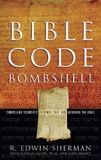 
Bombshell examines two massive, recently discovered clusters of codes in the Hebrew Old Testament. To read more about Bombshell, click here, or click below to order from Amazon today!
 
|







